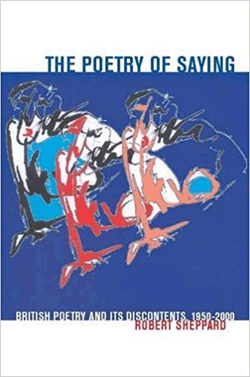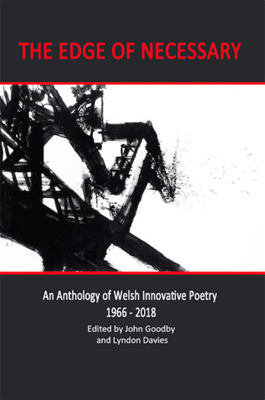 Just What Is British Innovative Poetry?
Just What Is British Innovative Poetry?  So What's Going On Now?
So What's Going On Now?  Recent Anthologies
Recent Anthologies  New Lists of Online Resources
New Lists of Online Resources
The best historical account available online of the development of an alternative poetry in Britain (or at least England), is still Robert Sheppard, A History of the Other. This is a detailed account, dated 2005, of the development of avant-garde British poetry since the 1960s (up to 2000), seeing a rather failed "British Poetry Revival" replaced by the slightly different (more self-aware in terms of its poetics) tendency labelled "Linguistically Innovative Poetry". His account has many close analyses. It is a very effective and detailed introduction by a poet and academic, to which I have really little to add but my agreement.
The sections are published on Sheppard's blog, Pages: a blogzine of investigative, exploratory, avant-garde, innovative poetry and poetics edited by Robert Sheppard, and are linked to below. But do explore the blog: you will encounter much excellent poetry, and other, often very pertinent essays by Sheppard. Much of the material (apart from the last section) will be found in his book The Poetry of Saying: British Poetry and its Discontents, 1950–2000 (Liverpool UP, 2005; £75!; text also available through JSTOR if you have academic connections).
and are linked to below. But do explore the blog: you will encounter much excellent poetry, and other, often very pertinent essays by Sheppard. Much of the material (apart from the last section) will be found in his book The Poetry of Saying: British Poetry and its Discontents, 1950–2000 (Liverpool UP, 2005; £75!; text also available through JSTOR if you have academic connections).
The "little press" activity from the very end of the 50s (Migrant Press) through to Fulcrum and Cape Goliard at the end of the 60s, via the interest in Modernist American poetry at Cambridge in the mid 60s.
The influence of the American Beats, focussing on Michael Horovitz's activities from 1959 (New Departures readings & anthologies, Royal Albert Hall Poetry Incarnation [1965], and the very inclusive Children of Albion anthology [1969]), and the British "beat poetry" scene of the 60s.
The rise of readings and small presses in late 60s & early 70s, culminating in the avant-garde take-over of the Poetry Society (a national membership organisation with London premises and a widely read magazine [Poetry Review]), and their expulsion in 1977 by a counter-coup. Plus the continuing development of "Cambridge" poetry, and its differences from the more London-based group (main poles Bob Cobbing and Eric Mottram).
Place – coming from the American poet Charles Olson's poetry and theorising – as a major factor in British avant-garde poetry in the 1970s (eg JH Prynne's The White Stones, Allen Fisher's Place, Iain Sinclair's Lud Heat). Plus early attempts to write a poetics for British avant-garde poetry, informed by the newly being assimilated French theory, and using Prynne as case study: Peter Ackroyd's Notes for a New Culture (1976) and the more influential Veronica Forrest-Thomson's Poetic Artifice (1978).
The recovery through the late 1979s and 1980s from the nakba of 1977: rallying in small groups in small rooms, with reading series, and new small presses and magazines. Plus the deepening influence of critical and literary theory, and of the American Language Poets. Much referred to is the 1988 anthology, The New British Poetry.
The focus switches to look more at Cambridge, with discussion of Angel Exhaust (for which see both editor Andrew Duncan's website and issues on poetrymagazines.co.uk) and Parataxis magazines, the Equipage pamphlets and the Cambridge Conference of Contemporary Poetry (1991–2006). Also discussed is the 1996 anthology, Conductors of Chaos.
Not to be confused with the populist performance poetry to be found in most cities and towns (a distant descendent of the British Beats of the 1960s heavily cut with hip-hop and stand-up). This is innovative poetry rooted in performance or site. Sheppard draws attention to the role of Dartington College of the Arts.
The typically sexist assumptions of the 60s Poetry revival were succeeded by a continuing male preponderance of writers, and a problematic exclusion of innovative work from feminist canons.
An interesting series of observations based on a number of anthologies:
Discussing these anthologies, Sheppard also draws attention to the dominant poetry mainstream ideology, dating from the 1950s, the Movement Orthodoxy of communicability and accessibility.
Interestingly, the two most recent anthologies his account ends with by discussing (on his online posting of this material) are still maybe current: Keith Tuma, Anthology of Twentieth-Century British and Irish Poetry (2001) and Nicholas Johnson, Foil: defining poetry 1985–2000 (2000). Published since his postings, but crucial to a real sense of BIP's history: Geraldine Monk's anthology of recollections Cusp: Recollections of poetry in transition (Shearsman, 2012), covering activities ranging for the 60s to the early 90s (mainly outside of London & Cambridge), and Bruce Wilkinson's very detailed Hidden Culture, Forgotten History: A northern poetic underground and its countercultural impact (Penniless Press, 2017), discussing majorly countercultural poetry scenes in East Lancashire and their contexts and implications (which still resound).
So What's Going on Now? takes the story on. But I'll just deal with some important activity that blossomed between 2005 and the present decade. In May 2006 Alex Davies and Steve Willey started a series of events in London labelled Openned that revealed a breathtaking inclusivity, relevance and openness: "Openned walks the line between finding readers from within, and initiating projects for, its own immediate community whilst attempting to wedge that community open, welcoming newcomers. The aim is to expand the cultural, social, and aesthetic space, and political import, of poetry." It did that well, with a superb website documenting its activities and acting as a useful notice board (particularly for activities in the South). Energy was given to the system, that survived the ending of their events and the freezing of the website (2009). Meanwhile, and apologies throughout for my south centred vision always, a high level of activity occurred in "the North" (particularly Liverpool-Manchester-Sheffield). In April 2008 ![]() was started as northern equivalent to Openned by James Davies, Tom Jenks and Scott Thurston, as a reading series and major information website, with an increasing expansion of readings and other activities in Yorks/Lancs (continuing despite The Other Room's demise in early 2018). Indeed, generally there has been an increasing number of local reading series and even festivals (eg Brighton Poetry Festival from 2009) across England and Wales, spreading way beyond the now irrelevant London-Cambridge axis/gap that monopolised discussion of innovative poetry in the late last century.
was started as northern equivalent to Openned by James Davies, Tom Jenks and Scott Thurston, as a reading series and major information website, with an increasing expansion of readings and other activities in Yorks/Lancs (continuing despite The Other Room's demise in early 2018). Indeed, generally there has been an increasing number of local reading series and even festivals (eg Brighton Poetry Festival from 2009) across England and Wales, spreading way beyond the now irrelevant London-Cambridge axis/gap that monopolised discussion of innovative poetry in the late last century.
It's a national scene (giving Scottish poetry its own space and tradition, which is not alien to us, as it has welcomed innovation more openly than the English mainstream).  Anglophone writing in Wales always has a more curious status than the equivalent in Scotland - Welsh is the national language more strongly than Gaelic. Welsh poetry has a strong and powerfully idiosyncratic tradition since its earliest days that continues still - see, say, Rhea Seren Phillips' site Grandiloquent Wretches ("A poetry project exploring the cultural identity of modern Wales") for details. But a specifically Welsh innovative poetry, in English (tho often aware of Welsh) is possible, as a companion, friend and on the evidence provided superb exemplar to more narrowly English "British Innovative Poetry." See the anthology edited by John Goodby and Lyndon Davies, The Edge of Necessary: An Anthology of Welsh Innovative Poetry 1966–2018 (Boiled String Press and Aquifer Books, 2018). Irish poetry is itself, though like Welsh poetry often struggling with conservative nationalist essentialism, and there has been fruitful interchange between the two islands, as the listings should indicate.
Anglophone writing in Wales always has a more curious status than the equivalent in Scotland - Welsh is the national language more strongly than Gaelic. Welsh poetry has a strong and powerfully idiosyncratic tradition since its earliest days that continues still - see, say, Rhea Seren Phillips' site Grandiloquent Wretches ("A poetry project exploring the cultural identity of modern Wales") for details. But a specifically Welsh innovative poetry, in English (tho often aware of Welsh) is possible, as a companion, friend and on the evidence provided superb exemplar to more narrowly English "British Innovative Poetry." See the anthology edited by John Goodby and Lyndon Davies, The Edge of Necessary: An Anthology of Welsh Innovative Poetry 1966–2018 (Boiled String Press and Aquifer Books, 2018). Irish poetry is itself, though like Welsh poetry often struggling with conservative nationalist essentialism, and there has been fruitful interchange between the two islands, as the listings should indicate.